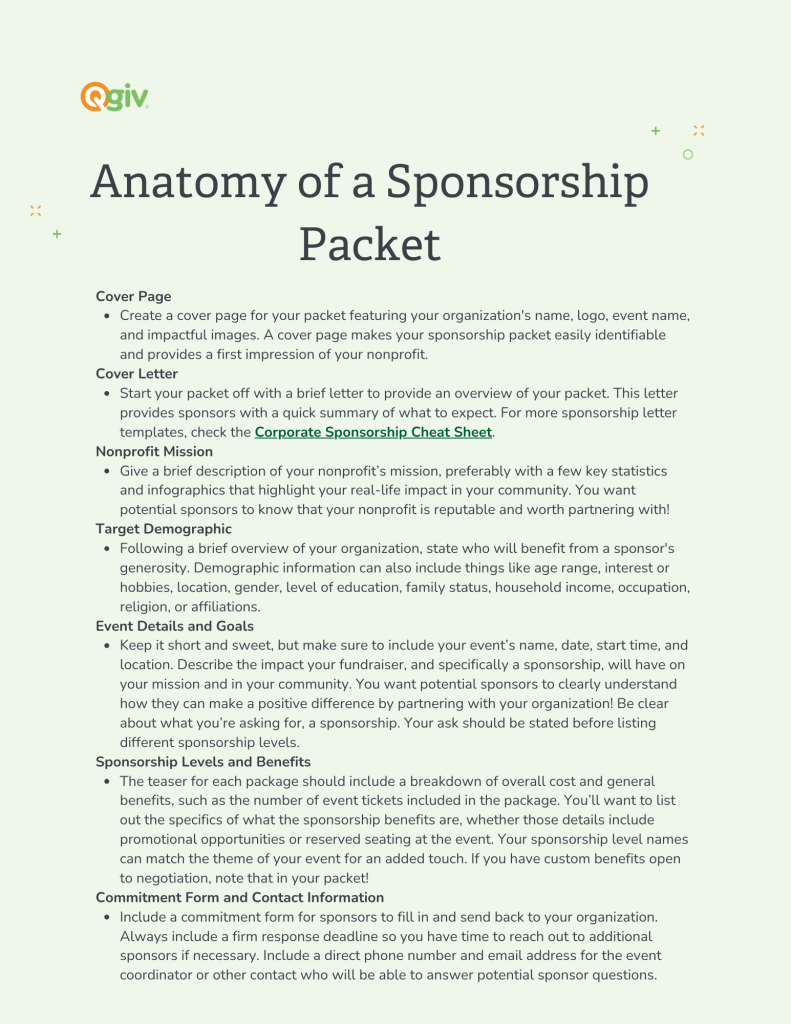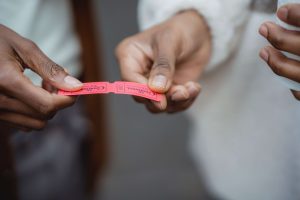Having a sponsorship packet template can be a real time-saver for your organization! Whether you’re looking for in-kind donations for promotional campaigns or financial sponsorship for an event, corporate sponsorships are a great way to make your budget go further while increasing reach and awareness for your cause. The right partnership can even help boost your nonprofit’s credibility in your community!

Once you’ve found the right partner, you’ll want to create a sponsorship proposal to send to your potential sponsor. This is where a sponsorship packet template comes in! You can put together a professional sponsorship packet that will help you secure those coveted sponsorships using this guide to build your proposal.
- What information should a sponsorship packet include?
- How to create a professional-looking sponsorship packet
- 6 steps to create a sponsorship proposal packet
- Sponsorship packet design
- Ideas to make your packet stand out
What is a sponsorship packet template?
A sponsorship packet is a comprehensive proposal that outlines the details of a partnership between a potential sponsor and your organization. A sponsorship packet template is a framework of what to include in your proposal that you can fill in information about the event or cause requiring sponsorship, along with the benefits and opportunities available to the sponsoring party.
Why should you make a sponsorship packet template?
Creating a sponsorship packet template has several benefits for your nonprofit. Firstly, it provides a professional and organized approach to seeking sponsorships that helps potential sponsors understand how serious your proposal is. Secondly, a good sponsorship packet can help you communicate the benefits of the collaboration and make a compelling case for why your cause should be sponsored. Thirdly, having a template ready to go can save your organization time that can be spent on other needs without sacrificing a potential source of funding.
What information should a sponsorship packet include?
Ready to create a sponsorship packet that helps your nonprofit stand out? Read on to get an understanding of the 8 key elements you should include in your corporate sponsorship proposal.
Cover page
Including a cover page in your sponsorship packet can increase recognizability while serving as the initial introduction to your nonprofit. When designing the cover page, ensure it showcases key elements, such as your organization’s name, logo, event name, and compelling images that resonate with your mission and values. This attention to detail in creating a visually appealing cover page can significantly impact how potential sponsors perceive your nonprofit and its initiatives.
Cover letter
Start off your packet with a concise letter providing an outline. This introductory letter serves as a sneak peek for sponsors, giving them a quick glimpse of what they can expect to find within the packet.
Nonprofit mission
There are over 1.5 million nonprofits registered in the U.S. alone. Instead of hoping your potential sponsor is familiar with your work, be sure to include a brief description of your nonprofit and your mission!
You’ll also want to include a few key stats to show why your nonprofit is an expert at serving your clients. Potential metrics to share include how long you’ve served your community, the number of clients served each year, or other metrics that describe real impact in your community, like a substantial increase in unhoused citizens finding permanent housing through your nonprofit.
Think of this as your elevator pitch: you want to keep it short, but make sure your nonprofit stands out!
Target demographic
As much as business owners love to give back to their communities, they also need their sponsorship package to include features that reach their target demographic. This will ensure their sponsorship is financially viable for them. For example, a used car dealership might not be a great sponsor for an event targeting your major donors, but it could be perfect for a family-friendly event in support of animal rescue.
Including details about your potential attendees—such as age range, interests and hobbies, or location—can help your potential sponsor determine if your event is a good fit for their audience. Demographic information can also include things like gender, level of education, family status, household income, occupation, religion, or affiliations.
Fundraising event details and goals
Don’t forget to include your event’s name, date, start time, and location. While you want to keep this section short and sweet, it’s also important to include other key details, such as if your event will include a silent auction.
If you need to raise a certain amount through your event, make sure to include that information for your potential sponsors. However, don’t just give your sponsors the dollar amount, describe the impact that amount will have in your community.
Sponsorship levels and benefits
It’s important to include a quick breakdown of all the sponsorship levels your nonprofit is offering. The teaser for each package should include a breakdown of overall cost and general benefits, such as the number of event tickets included in the package, and if the sponsor will be eligible for promotional opportunities.
This is also where you can break down the specifics of what the sponsorship benefits are. For example, if you listed promotional opportunities for some of your sponsorship levels, you’ll want to break down exactly what that means.
Will top-level sponsors have their logos added to print materials? Will they get a mention and backlink on your nonprofit’s website? Will their sponsorship be mentioned in press releases?
Getting specific with the details can help your potential sponsors decide which package is going to give them the greatest return on their investment. When talking about social media promotions, it’s a good idea to go into even more detail and share specific information on the number of mentions they’ll get, the number of followers you have on each channel, and the reach for event posts from last year (if this is a repeat event).
Powered by Bloomerang
Commitment form and contact information
Include a commitment form for sponsors to fill in and send back to your organization. This form should outline the sponsorship details, such as the agreed-upon contribution amount, benefits to the sponsor, and any specific terms or conditions.
Always include a response deadline in any sponsorship request. While it’s great when everyone on your first-round sponsorship list says yes, the reality of the situation is that it’s rare that you’ll get 100% of your sponsors during your first round of outreach. You’ll want to give yourself enough time to reach out to another round of sponsors in plenty of time to create your promotional materials.
Last—but certainly not least—don’t forget to include contact information for the person in charge of the event. Ideally, you’ll include both a direct phone number and email address. If the person handling sponsorships is not the person in charge of the event, make sure your sponsorship coordinator is prepared to answer any questions potential sponsors might have. It’s also a good idea to include your website at the end of your signature, so your potential sponsor knows where to go if they want more information.
How to create a professional-looking sponsorship packet
Whether you need a sponsorship letter for a sports team or for a formal event sponsorship proposal, creating a professional-looking sponsorship packet can seem intimidating if you don’t have a professional graphic designer on your team. While great graphic design can be an invaluable tool for communicating your nonprofit’s branding, there are plenty of free design tools that nonprofits can rely on to create eye-catching graphics. Here are a few resources:
- Visme is a tool that first came on my radar due to its video content capabilities. However, Visme offers far more than video-creating tools, and is a great place to design anything from social media graphics to infographics highlighting your nonprofit’s success.
- Canva Probably the most well-known in the free design tool space, Canva is an intuitive platform that offers a robust free tier, as well as paid professional accounts. You can easily use their tools to create everything from social media graphics to polished presentations and yes, even sponsorship packets.
- Easil is a drag and drop design platform with a variety of professional templates to choose from. While Easil offers a great free platform, their paid plan can help your whole team stay organized when working on design projects.
- VistaCreate can help you create great graphics in minutes for free! The tools offer thousands of professional templates that you can edit to meet your specific needs.
- Pixlr is a web-based online editor that allows you to edit photos and create designs right in your browser. Pixlr works with almost any type of image format and offers AI-powered tools for easy edits.

6 steps to create a sponsorship proposal packet
Securing sponsorships can be a game-changer for your organization. Whether you’re supporting a campaign or planning a major fundraising event, sponsorships can provide the crucial funding to help you achieve your goals. But how can you create a compelling sponsorship proposal that stands out? Here are six simple steps to creating your sponsorship packet:
1. Research your sponsors
Before you ask about a sponsorship, you need to do your research on your potential sponsor to ensure they’ll be a good fit. Here are a few key points to look into:
- Identify values. Find your sponsor’s values and interests to make sure they align with your nonprofit.
- Understand their audience. Knowing your sponsor’s target audience demographics and preferences can help you tailor your proposal to show how sponsoring your event can help them.
- Gather past sponsorship information. Look into previous sponsorships your sponsor has provided to understand what types of partnerships they prefer.
2. Decide your sponsorship levels and benefits
Once you understand your sponsor, you’ll know what type of benefits they’re looking for and what sponsorship level to offer. Ensure to include the following:
- Create tiered levels. Offering tiered sponsorship levels can attract sponsors with different budgets. Each level should have clearly defined benefits that increase with their investment.
- Define benefits. Clearly outline the benefits of each level, including brand exposure, exclusive access, naming rights, and other specific benefits to attract sponsors.
- Provide value-added options. Offer additional options like VIP passes, speaking opportunities, or co-branded merchandise to entice sponsors.
3. Connect your event to your sponsors
Connect your event to the sponsor’s goals, showing why they should invest. Here are a few ways you can show why they should sponsor your event:
- Highlight mutual benefits. Show how your event helps your potential sponsor achieve their objectives and values.
- Tell impactful stories. Use testimonials, success stories, or impactful statistics to show how your sponsor can make a positive change in your community,
- Showcase your audience. Present data on your event’s reach and audience demographics. Provide statistics, attendee profiles, and past event successes to showcase your event’s impact.
4. Communicate with sponsors before and after sponsorship requests
Effective communication is key to strong sponsor relationships. This includes ongoing communication before, during, and after the event. Here are key times you should communicate with your sponsors:
- Initial contact. Reach out to potential sponsors with a personalized message to familiarize them with your mission and how they can make an impact.
- Regular updates. Keep sponsors informed with regular updates leading up to the event to keep them engaged with your event.
- Post-event follow-up. After your event, follow up with a detailed report on your successes with metrics such as money raised, potential impact, attendance, and social media engagement.
5. Thank your sponsors
Expressing gratitude can help you build lasting relationships with sponsors. Use these appreciation ideas to show your gratitude:
- Personalized thank you. Send a personalized thank-you message to each sponsor and highlight their specific contributions.
- Public recognition. Publicly thank your sponsors through social media, event programs, or press releases to show your appreciation while providing additional exposure for their brand.
- Gifts. Consider sending a small gift or token of appreciation, like a framed event photo or custom memorabilia for an impactful gesture.
6. Ask for feedback
Seeking feedback from your sponsors provides you valuable insights to improve your future proposals and events. Here are a few ways you can ask for feedback from your sponsors:
- Feedback surveys. Create a feedback survey for sponsors to complete after your event. Ask what went well and what could be improved in the future.
- One-on-one meetings. If possible, schedule one-on-one meetings with major sponsors to discuss their experience and gather detailed feedback.
- Implement changes. Use the feedback you receive to make changes to your future proposals and events to show your sponsors your commitment to them.

Powered by Bloomerang
Sponsorship packet template design
While the graphic design tools can help you createa visually compelling sponsorship packet, there are a few best practices you should keep in mind when designing your nonprofit’s sponsorship packet:
- Keep it simple. Your potential sponsors are busy. Make it easy for them to make a decision by keeping your design clean, organized, and to the point. Use a simple color scheme with no more than 2-3 bright colors and a couple of classic neutrals to keep your design focused.
- Make it visual. It’s also important to minimize text, just like you would if you were creating a presentation to present to your board. Avoiding long paragraphs (anything over 5 lines or 3 sentences) will make your sponsorship packet easier to read and digest.
- Keep branding consistent. Keeping your branding consistent helps your nonprofit look professional. It also helps build trust, since potential sponsors will be able to verify that they are working with a legitimate nonprofit with a quick Google search.
- Use white space. Don’t cram all your text and design elements together. Use white space so each element can breathe. This makes it easier for your potential sponsors to read.
- Focus on impact. Unlike a basic sponsorship letter, a sponsorship packet gives you a little more room to add some flair in the form of concrete impact statements. For example, a simple call out that says “One $1,000 sponsorship = 200 meals served” helps your sponsor visualize the impact their contribution can have on the community.

Ideas for a unique sponsorship packet template
Are you struggling to make your sponsorship packet stand out? You’re not alone! From incorporating digital components to using compelling images and videos, these tips are designed to help you entice your potential sponsors.
Include digital components
Adding digital components to your sponsorship packet template can significantly boost engagement. People love interactive content—it’s fun, memorable, and can convey your message more effectively than plain text. Embed QR codes that link to websites, videos, or virtual tours of your organization to keep your sponsors engaged and offer them a deeper understanding of your mission.
Use compelling images from volunteers and people you’ve helped
Nothing resonates more than real stories and faces. Include compelling images of volunteers and the people you’ve helped in your sponsorship packet to add a personal touch and make your cause more relatable. You can show the tangible impact of your work through before and after photos and illustrate the difference your organization makes. Include captions that explain the story behind each photo.
Design graphs to break down data
Data can be overwhelming, but it’s essential for demonstrating the impact of your work. Use graphs and infographics to break down complex information into easily digestible visuals. Whether it’s the number of people helped, funds raised, or projects completed, well-designed graphs can help highlight your achievements in a way that ensures your sponsors understand the impact of your work.
Create example images of advertising perks
When offering advertising perks for your sponsors, create example images to showcase these opportunities. For instance, if a sponsor’s logo will be featured on event banners, T-shirts, or your website, provide mockup visuals to help potential sponsors understand how their brand will be showcased. Visual examples make it easier for sponsors to see the value in higher-level contributions.
Record video statements from volunteers, staff, and board members
Videos add a personal touch to your sponsorship packet. Record statements from volunteers, staff, and board members explaining why they’re passionate about your cause. These videos humanize your organization and make it more relatable to donors. Share success stories through video. Hearing directly from beneficiaries about how your organization has impacted their lives can be incredibly moving. Videos convey emotions and stories in ways that words alone cannot.
Final thoughts
And there you have it! Creating a sponsorship packet can help your organization find more sustainable funding rather than relying solely on individual contributions–and this guide can help you create a memorable proposal for your potential sponsors. Don’t forget to download a copy of the sponsorship packet template to keep on hand for future events.
Additional resources
Need ideas for planning your next fundraising event? Check out the following resources:
- How Nonprofits Can Secure Corporate Sponsorships. Learn how you can secure a corporate sponsorship for your organization with this guide!
- Fundraising Events: 100+ Ideas to Try in 2024 and Beyond. Check out this list of fundraising event ideas for inspiration.



